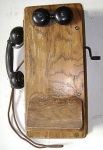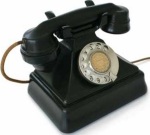In 1948, when I was six, most homes had a phone (but not all), and those that did have a phone only had a landline (no mobiles in those days).
The first phone I can remember hung on the wall, just inside the front door of our Maungaturoto house, and looked something like the one in the picture below. To use it, you picked up the handset on the left and turned the crank on the right around a couple of times. Doing this made a light flash at the nearest telephone exchange, and an “operator” (a human being; almost always a woman) would ask you what phone number you wanted.

The “operator” would then physically plug the wire your call had come in on into the hole representing the number you wanted and turn a little handle to make the other person’s phone ring. The machine the “operator” used was called a “switchboard” and looked like this:

Simple, eh? But wait, there’s more!!!
In rural areas, like Maungaturoto, most people at that time had what was called a “party line”. That meant there might be four or five houses sharing the same phone line, and it also meant that only one family could use the phone at any one time. So, when the “operator” rang your number, how did you know whether the call was for you or for one of your neighbours?
The answer is that everyone on a party line had a “letter” as well as a “number”. For example, a family’s phone number might have been something like “12D”. When the “operator” wanted “12D” to answer , they would plug the call into the hole for phone number “12” and would crank out one long ring followed by two short rings (which is Morse Code for the letter “D”). That long-short-short code would sound on the phones of all the families on that “party line”, but, because they all knew what their code was, only one person would answer.
I told you, simple.
The English language has changed over the years to reflect our changing phone technology. Here is an explanation of some old-fashioned phone-related phrases:
“I hung up on him”: In the days when phones hung on the wall, you used to end a call by physically hanging the handset back on the phone.
“I rang off immediately”: When you finished your phone call on a party line, it was polite to crank out a short little ring, which would sound on all your neighbours’ phones, to tell them that you’d finished and that the line was now available for other calls.
“I put the phone down and ran out of the house”: Later, phones looked like the one below, so you ended a call by putting the handset back down on the phone. (By the way, in those days all phones in New Zealand were black.)
